Ceramics-Ireland, spring/summer 2004
TOON THIJS : CERAMIST
In 1988 Toon Thijs started as a professional ceramist and in 1995 he established a new workshop and Gallery in Nijmegen, Netherlands. Here he discusses his influences and progress from student days to a professional ceramist and gallery proprietor.
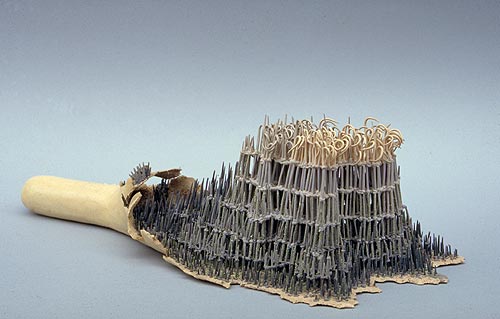
Toren van Babel - 1990 - 45x24 cm, h 15 cm
When Hester asked me to write this article, it was at Clay Art, a pottersmarket in Denbigh - North Wales. Doing markets was a deliberate choice, when I started as a professional ceramist and it still is.
For me I think it means: Showing work of a standard you can see in high class galleries and books or magazines, but just on the street, on a meadow or in a cattle market, close to the community, with a good chance of a large audience. A direct possibility to meet people interested in ceramics, to talk to them and to sell. Very important, because sales are essential as they fund the making proces.
But it also means a splendid opportunity to meet people like yourself potters/ceramists from all over Europe. Exchanging information, swapping ideas, having the same problems, seeing new techniques, laughing, joking, eating, drinking.......making new friends.
Now, based in the Netherlands, I am taking part in national and international markets with a very high standard of work in the Netherlands (Milsbeek, Swalmen, Gouda, Dwingeloo); in the UK (Penrith, Hatfield, Denbigh, Farnham, Rufford, South Wales); in Germany (Frechen, Krefeld, Hohr-Grenzhausen, Hanau); in Austria (Gmunden); and in France (Melun, Cordes sur Ciel).
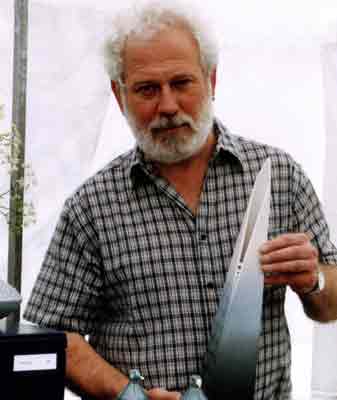
I did not start my professional career as a ceramist, but as a teacher, firstly at a primary school then later teaching art and art-history at a secondary school. Studying at two different Art Colleges I was not especially interested in ceramics at first. That interest arose between 1977 and 1980 at the Academy of Art in Arnhem (NL), thanks to one of my teachers there. He did not try to "model" me in an academic way, but gave me the freedom to experiment; to discover my own ways of working with clay, slips and glazes. Not by making domestic wares, but telling stories by making pieces of art.
It was not until 1988 that I had the courage, at 40 years old, to become a professional ceramist starting Ceramic Studio Toon Thijs. The first years I made one-off pieces like I did at the Academy of Art. Those pieces were remarkable because I built new complexe structures with individual small elements and slip, like in the "Toren van Babel". On the one hand monumental like a building, on the other fragile like cobweb. It was not coloured by glazing, but I used coloured clay and slips.
As well as these one-off pieces I started to make limited series (multiples) of unusual and decorative objects with their own unique character. Not domestic wares but personal designed objects; austere in shape, with a great sense of detail and later with colour. Then I also started to use glazes instead of coloured slips. Now I mainly colour with glazes. The glazing takes a lot of time, because I never keep myself to one glaze. Layer over layer I built them up; sometimes on top of underglazed patterns; sometimes using stencils. Because of this procedure I can get a wide range of colours in one object. I can use the colour to give a flat surface depth; I can make an object "lighter" as if it hovers.

Sail - 2002 - diam. 32 cm, h 7 cm
You can still see an influence from my art-education in my present work. That education was strongly influenced by the principles of the Bauhaus; that famous Artcollege in Dessau (Germany) with teachers like Kandinsky and Paul Klee. One of the main principles was: basic shapes of good design should be simple and clear. Good design should be built up with geometric shapes like sphere, cylinder, cube, cone or parts of those basic forms. Designing was "playing" with this material; try to find a lot of variations with the same elements. The assemblage of all those parts should also be clear and noticeable; part of the design. According to these principles you should prefer to use primary colours or colours directly derived from those. Colour should have a strong relationship to the shape; it should be used not just as a surface.
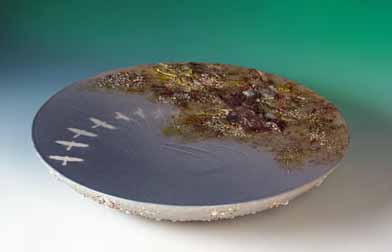
Serie Life - plateau III - 2000 diam. 40 cm, h 8 cm
You can still find a lot of these Bauhaus-principles in my present work. Very often primary forms are the starting point of my ceramics. For example: all my bowls and "plateaus" are segments of a sphere. But now I try to change those basic forms by attacking them, by perforating them. Sometimes they burst open and then organic elements are added like pebbles, little shells, little "mushrooms", "seed", but also little lizzards, turtles or a dead bird. Very often I make a lot of variations on the same theme, a technique that I was taught at college. But now my work is no longer only abstract; it is a combination of geometric and organic elements. Also colour is a main part of my ceramics. I like bright and clear colouring with strong light-dark differences. I still prefer - like the Bauhaus people- when colour is not only a fashionable surface.
Next to this inspiration there is a social one. For a long time I have been greatly interested in the writings of Nescio (1882-1961), a Dutch writer. One of the most important themes in all his novels is the dilemma between the ideal world and reality; between "happiness on the top of the mountain" and "grief in the valley". He likes to tell about little Titan's fighting against the bourgeois; trying to attack God and change the world. I like to make pieces inspired by these themes, like I did in "Boven het dal" (Above the valley). So far, I have not had enough time to develop these themes, but I will certainly return to pieces like that from time to time.
Although I am very interested in ceramic techniques the starting point of all my work is not in traditional ceramic techniques, like throwing, special firings, salt-glazing, making slip-ware and so on. I first try to find unusual designs with underlying concepts. I start with thinking; with ideas and then I need all my ceramic know-how to give them shape
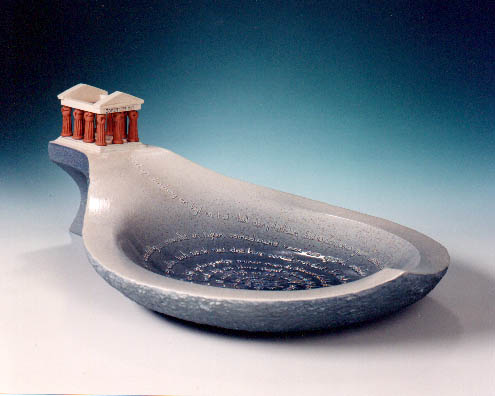
Boven het dal - 1998 - 43x30 cm, h 15 cm
I usually start drawing and making models. Sometimes with clay, but also with cardboard, wood or metal, when clay is not precise enough. That process can take a lot of time, because I am not easily satisfied. Whenever I am happy with the design I start to produce the objects using all kind of ceramic techniques. Very often I first make the basic geometric forms by slip-casting or slab-building.
Sometimes they consist of several parts, then when leather-hard, the basic form is cut, perforated, parts are made plastic again and transformed and new elements are added. Those new elements are often modelled with coloured clay and build up with tweezers. Mostly these elements are handbuilt; sometimes press-molded like the little lizzards or turtles. I am using a very fine, white earthenware clay. The same clay used in the Delft and Gouda industries (like the famous "Delft Blue"). I fire it electrically at 1080 degs C.
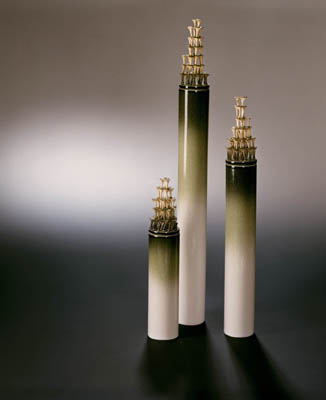
Drie torens - 2003 - h 50/36/25 cm
In 1995 I moved to a new workshop in a former bakery. There I becam a Gallery proprietor too. Adjacent to the studio I established a Galley/ exhibition space. In the gallery, alongside my own current work I hold special exhibitions with the work of national and international ceramists. I also keep ceramics in stock from makers like Eddie & Margaret Curtis (UK), Horst Gobbels (G), Richard Godfrey (UK), Roger Lewis (UK), Levas & Lina Bekeras (Lt),Sally & Alasdair McDonell (UK), Netty Janssens (NL), Ardine Spitters (F), Willy van Bussel (NL), May Criado (Sp). Acting as a gallery-keeper is quite a new part of my life as a professional ceramist: it widens my scope.